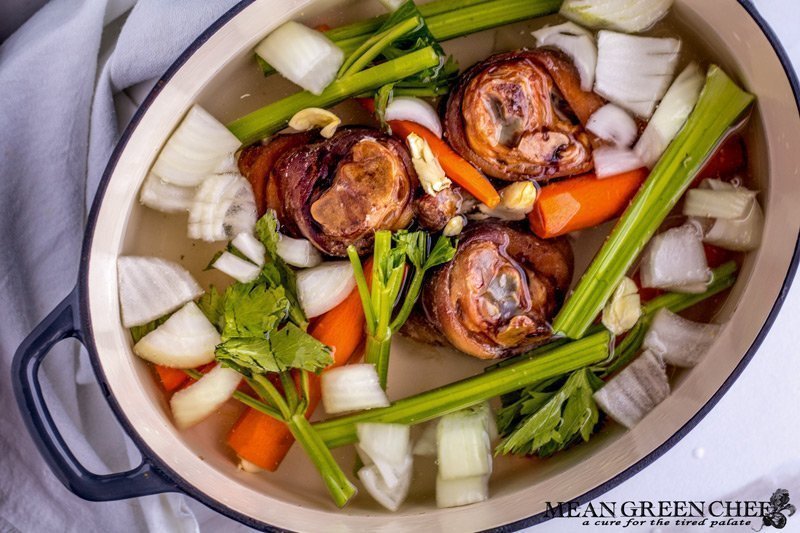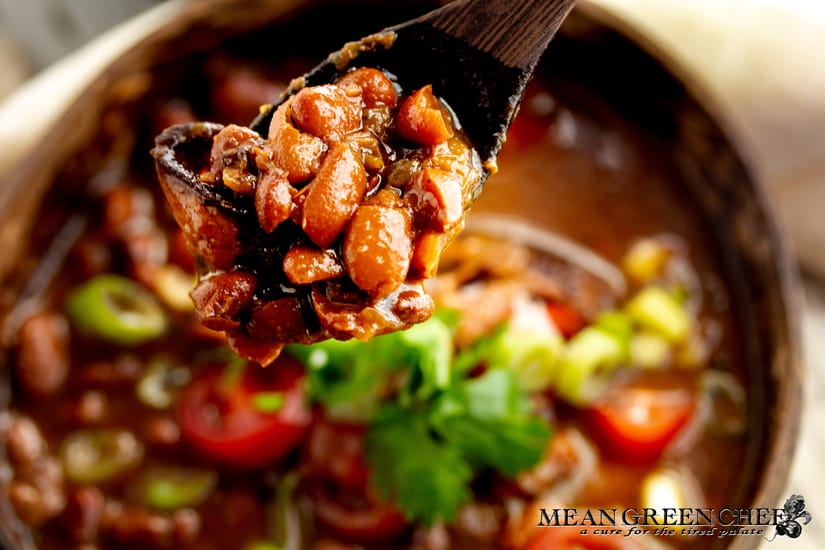Our Ham Hock Stock is an easy way to create an amazing depth of flavor in Cajun foods, soups, stews, collards, beans and so much more. We utilize smoked ham hocks and cook them down until they fall off the bone and impart incredible taste!
We are big believers in using the freshest ingredients possible, it’s a key factor in enhancing the flavors and quality of any dish. This is a back to basics method, use up vegetables or herbs that you have on hand or follow our recipe to a tee.

carte du jour
ToggleHam Hock Stock History
Ham hock stock traces its roots back to traditional European cooking, where every part of the animal was utilized to create flavorful dishes. Originally, ham hock stock served as a staple in peasant kitchens, providing a rich and hearty base for soups, stews, and sauces.
Over time, this humble stock gained popularity for its depth of flavor and versatility in culinary applications. Today, ham hock stock continues to be cherished in both home kitchens and professional settings, celebrated for its ability to add complexity and richness to a wide range of dishes.
You can’t go wrong, but there is one hard and fast rule! Don’t add any salt at this time, due to the salt content in ham. You will adjust for taste after the stock finishes cooking.
What Are the Uses for Ham Hock Stock?
This ham stock recipe can be added to virtually any dish where you desire a smoky flavor boost.
- Soups: Ham hock stock serves as a flavorful base for hearty soups such as split pea, bean, or vegetable soup.
- Stews: Use ham hock stock to add depth of flavor to meaty stews like beef stew or cassoulet.
- Sauces: Incorporate ham hock stock into sauces and gravies for a rich and savory taste.
- Risotto: Enhance the flavor of risotto dishes by cooking the rice in ham hock stock.
- Braised dishes: Use ham hock stock as a braising liquid for meats such as pork, chicken, or beef.
- Beans and legumes: Use ham hock stock to cook beans and legumes for added flavor and richness.
Southern Comfort: Flavorful Collard Greens Infused with Ham Hock Stock
Ingredients:
- Collard greens, washed and chopped
- Ham hock stock
- Ham hock (optional, for added flavor and texture)
- Onion, diced
- Garlic, minced
- Salt and pepper to taste
- Red pepper flakes (optional, for a bit of heat)
- Olive oil or bacon grease for sautéing
Instructions:
-
Prepare the Collard Greens: Wash the collard greens thoroughly under cold water. Remove the tough stems and chop the leaves into bite-sized pieces.
-
Sauté Aromatics: In a large pot or Dutch oven, heat some olive oil or bacon grease over medium heat. Add diced onions and minced garlic, and sauté until they become translucent and fragrant.
-
Add Collard Greens: Once the onions and garlic are softened, add the chopped collard greens to the pot. Stir well to coat the greens with the aromatics.
-
Pour in Ham Hock Stock: Add enough ham hock stock to the pot to partially cover the collard greens. If using a ham hock for extra flavor, you can add it to the pot at this stage.
-
Season: Season the collard greens with salt, pepper, and red pepper flakes to taste. Keep in mind that the ham hock stock may already be seasoned, so adjust the seasoning accordingly.
-
Simmer: Bring the pot to a simmer over medium-low heat. Cover and let the collard greens cook, stirring occasionally, until they are tender and flavorful. This usually takes about 30 minutes to 1 hour, depending on the desired level of tenderness.
-
Check for Seasoning: Taste the collard greens and adjust the seasoning if necessary. Add more salt, pepper, or red pepper flakes to suit your taste preferences.
-
Serve: Once the collard greens are cooked to your liking, remove the ham hock (if used) and discard any bones or skin. Serve the collard greens hot as a side dish or over rice for a hearty meal.
Flavoring collard greens with ham hock stock adds depth and richness to the dish, making it a comforting and flavorful addition to any meal. Adjust the seasoning and cooking time according to your taste preferences and enjoy the delicious flavors of this Southern classic!

Essentials for Crafting a Smoky Ham Hock Stock
In a sizable heavy-bottomed Dutch oven or stockpot, position the ham hocks. Fill with water and bring it to a boil. Once boiling, discard the water. Rinse both the ham hocks and the pot thoroughly, then return the hocks to the cleaned pot. This process effectively removes impurities from the hocks.

After scrubbing the vegetables and halving any large pieces, add them to the pot with the hocks. Slowly pour in the 4 quarts of cold water to prevent disrupting the fat on the hocks, which could lead to a greasy and cloudy stock. Ensure the water just covers the ingredients.

Begin by placing the pot over medium-high heat and bringing it to a slow rolling boil. Then, reduce the heat to medium-low and adjust it further until you achieve the barest simmer, characterized by occasional bubbles every few seconds. This gentle simmering is essential for melting and dissolving the collagen in the meat, enriching the stock’s flavor. Throughout the cooking process, remember to skim the surface occasionally to remove any foam.
During the initial half-hour, consistently check and skim off any foam accumulating on the surface. As this time elapses, the foam should diminish, allowing you to check back every hour or so and gently stir the pot to prevent ingredient dehydration.
- As the liquid reduces, the flavor will become more concentrated. After 4 hours check for flavor, it should be seasoned beautifully at this point. Remove the ham hocks to a platter and set aside.
- Strain the stock through a fine-mesh strainer and discard the vegetables. Allow the stock to cool if not using immediately.
Note: As the liquid reduces, the flavor will become more concentrated. After 4-hours check for flavor, it should be seasoned beautifully at this point. Remove the ham hocks to a platter and set aside.
Ham Hock Stock can be refrigerated in an airtight container for up to 3 days or frozen for up to 1 month.
Please Pin to Make & Share!📌

Preserving Flavorful Base: Storing Ham Hock Stock for Extended Usability
Ham hock stock, a rich and flavorful broth made from simmering ham hocks with aromatics and seasonings, can be stored to maintain its quality for future use. Here’s how:
Cooling: Allow the ham hock stock to cool to room temperature after it has finished cooking. Avoid leaving it at room temperature for too long to prevent bacterial growth.
Straining: Once cooled, strain the ham hock stock to remove any solids such as bones, vegetables, and herbs. A fine-mesh sieve or cheesecloth can help achieve a clear and smooth stock.
Storage Containers: Transfer the strained ham hock stock into clean, airtight containers. Choose containers that are suitable for both storing and reheating liquids. Glass jars, plastic containers, or freezer bags are all good options.
Refrigeration: If you plan to use the ham hock stock within a few days, store it in the refrigerator. Make sure the containers are tightly sealed to prevent any odors from permeating the stock. Properly refrigerated ham hock stock can typically last for 3-4 days.
Freezing (Optional): For longer-term storage, you can freeze the ham hock stock. Allow the stock to cool completely before transferring it to freezer-safe containers or bags. Leave some room for expansion as the liquid freezes. Frozen ham hock stock can maintain its quality for several months.
Shelf Life: When stored properly in the refrigerator, ham hock stock can last for 3-4 days. If frozen, it can maintain its quality for several months. However, for the best flavor and texture, it’s recommended to use the stock within a reasonable timeframe.
By following these storage guidelines, you can ensure that your homemade ham hock stock is always on hand to add depth and richness to your soups, stews, and other dishes.
How to Make Ham Hock Stock

Ham Hock Stock
Ingredients
- 3 large smoked ham hocks
- 3 carrots, chopped
- 3 celery ribs, chopped
- 1 onion, chopped
- 2 cloves garlic, smashed
- 2 bay leaves
- 1 teaspoon peppercorns
- 4 quarts water, cold
Instructions
- Put the ham hocks in a very large soup pot and cover with cold water. As soon as it comes to the boil, pour the water out. Rinse the ham hocks and the pot. This cooks off impurities on the hocks.

- Now add all of the ingredients and bring to a boil in a large heavy-bottomed Dutch oven or stockpot. Cover partially and simmer until flavorful and ham is falling off the bones, about 3 hours. Remove the ham hocks and then strain the stock and skim off any fat from the surface.

Notes
- Prep time is approximate.
- Ham Hock Stock can be refrigerated in an airtight container for up to 3 days or frozen for up to 1 month.
Creative Recipe Inspiration
Discover the hearty comfort of Dutch Stamppot with our authentic recipe. This traditional Dutch dish features a satisfying blend of mashed potatoes, vegetables, and often meat, creating a flavorful and wholesome meal.
Texas Pinto Beans – a hearty and flavorful dish that’s a staple of Texan cuisine. Slow-cooked with savory bacon, aromatic spices, and a touch of smoky chipotle, these beans are simmered to perfection for a rich and satisfying meal.
Step Into My Kitchen!
Hey there, fellow food enthusiast! Welcome to Mean Green Chef, where every dish tells a story and every recipe is a labor of love. I’m thrilled to share a bit about myself and the journey that led me here, stirring pots and sprinkling spices for over three decades!


Just a quick heads up – you might notice some affiliate links sprinkled throughout our site. If you decide to click on them and make a purchase, rest assured, it won’t cost you extra. Instead, you’ll be helping to support our blog and keep the kitchen fires burning. Thanks a bunch for your support!











I grew up in the south with lots of pork including ham hocks in dried beans – really good BTW but really lots of fat so I don’t do that anymore. I’ve never considered making ham hock stock but it sounds wonderful. You can get rid of the fat and still add flavor to everything! Pinned and shared
Hi, Carol 🙂 this is the perfect way to get the flavor without all the fat! Thank you so much for pinning too!